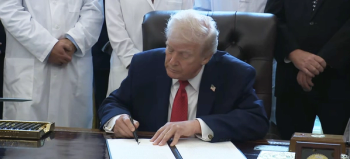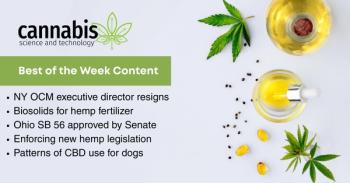Cannabis Science and Technology
- Psychedelics: New Frontiers in Alternative Medicine
- Volume 5
- Issue s1
Psilocybin Therapy for PTSD and Depression
An overview of the therapeutic role of psychedelics that goes back thousands of years, as well as the new research and the application of microdosing principles that have created renewed interest in the power of psychedelics.
The therapeutic role of psychedelics goes back thousands of years and more recently to the 1950s and 1960s, but new research and the application of the principles of microdosing have created renewed interest in the power of psychedelics. In the age of modern medicine and pharmaco-therapies for all types of psychiatric disorders it has become widely known over the last 50 years that selective serotonin reuptake inhibitors (SSRIs) and serotonin-norepinephrine reuptake inhibitors (SNRIs) do not help everyone. In addition, some disorders are treatment-resistant to current US Food and Drug Administration (FDA) approved therapies. In 2019, the FDA approved the drug Spravato (ketamine) for use in treating depression; this approval was a catalyst to revisiting psychedelics as a therapy for a variety of psychiatric disorders.
Two of the most common diagnoses that show response to psychedelic therapy are depression and post-traumatic stress disorder (PTSD). Because of the similarities in the way that the brain stores emotional experiences we will consider both diagnoses in parallel when it comes to the effects of how psychedelic therapy works. Trauma is coded in the brain by the amygdala and then the frontal lobes before various parts of the experience are encoded across many areas of the brain. But it is the amygdala that responds to, defines, and regulates emotion, as well as associated feelings of sadness, joy, or pain with the memory as it is stored.
The amygdala is part of the limbic system, a network of interconnected structures responsible for emotion and behavioral responses to stimuli and events. The amygdala activates the “fight or flight” response when we encounter danger or feel unsafe. Fight or flight is a survival response to both physical and emotional danger. Once the amygdala is triggered, messages are sent to the frontal lobes for evaluation. The frontal lobes are responsible for executive function. This area of the brain can evaluate the stimulus and determine an appropriate response, which includes overriding the amygdala’s survival response. If the amygdala does activate the fight or flight response, the limbic system then activates multiple physiological systems, including the sympathetic nervous system, which stimulates the release of a It is within this system adrenaline (epinephrine) and norepinephrine, as well as other stress hormones (1). It is within this system and during this process that memories and associated emotions are stored in the brain. This is why PTSD and depression are closely related with respect to how the messages are coded, stored, and accessed. With depression, the brain has trouble accessing joy associated with memories, whereas traumatic experiences are encoded with negative emotions; both require rewiring.
Trauma is an extreme form of emotional response to a distressing experience often caused by a sudden or unpredictable event (1). As we have seen and experienced with the COVID-19 pandemic, no one is able to avoid traumatic events. Trauma affects us all, and we each respond differently. Traumatic events include but are not limited to: the loss of a loved one, a violent situation, physical abuse, a car accident, or military combat experience. The trauma is stored in the brain, and when these memories are triggered, they can undermine a person’s sense of safety and trigger hypervigilance (1).
Once trauma is stored in the brain, it manifests in numerous ways. It can be subtle or obvious and often destructive. How someone responds to trauma is determined by multiple factors including past experiences, the type of event, the developmental stage and processes of the person experiencing the event, and the social and cultural environment. Manifestations or symptoms of depression or PTSD can include emotional struggles, sleep disturbances, anger issues, difficulty with professional or personal relationships, and even physical pain. Living in a high stress defense mode can then lead to “Amygdala Hijack” which is when the amygdala disables the frontal lobe and takes control or “hijacks” the brain.
Previous models of how the brain processes experience theorized that we receive stimuli from our environment, process the stimuli in higher functioning areas of the brain, and send out the signals with an appropriate response (12). However, new research suggests that the brain predicts what each unique situation or environmental model will be based on prior similar sensory inputs instead of each individual experience, a “predictive coding” theory. This is a way for the brain to function more efficiently when processing new information. When errors occur the brain corrects for the prediction error and adjusts the model. Andrew Clark, a cognitive scientist at the University of Edinburgh in Edinburgh, Scotland said: “You experience, in some sense, the world that you expect to experience,” (12).
Therapeutic analysis of a drug is observed based on an absorption, distribution, metabolism, and excretion (ADME) profile to understand and predict how the drug will work. With respect to FDA-approved drugs like ketamine, this data is widely accessible. However, for drugs such as cannabis or psilocybin, which are currently Schedule I drugs, research is limited, making it difficult to fully understand how the drugs work. Psilocybin is most commonly ingested orally as a raw mushroom, a capsule of powder, or as a powder mixed with food or tea. Psilocybin is absorbed in the gut and metabolized by the liver in first pass metabolism, and then its most prevalent area of known action into the body is through the 5HT 2A serotonin receptors (13).
Once ingested, understanding of how the drug works therapeutically is limited. Research and clinical trials are needed to discover how psilocybin works in the brain. Neural imaging indicates that psilocybin and psychedelics appear to activate all areas of the brain, a crucial factor in understanding why and how psilocybin works. Evidence also suggests that psilocybin has an exemplary safety profile with few harmful side effects, particularly when microdosing. When adverse side effects do occur, they appear to be related to 5HT 2A receptor problems, or reports of the classic “bad trip,” which can be frightening in the moment, but disappear when the drug wears off. However, people with a history of mental illness, such as schizophrenia or bipolar disorder should be thoroughly screened, and work closely with medical professionals if they are considering psychedelic therapy.
Current knowledge of how psilocybin works is predicated on an understanding of the “predictive coding” model of how the brain processes experiences and the role of the amygdala and the amygdala “hijack” process. Four key concepts that lead to the successful treatment of depression and PTSD with psilocybin therapy are: neuroplasticity of the brain, the “Default Mode Network,” rewiring of synapses and pathways, and surrendering control.
Neuroplasticity means the brain is malleable and can be reformed, adapted, regrown, or activated. This function is key when the goal is to rescript painful memories. The “Default Mode Network” is the system of the brain that functions when the brain is in a wakeful rest, such as daydreaming or ruminating, a common behavior with depression. Amygdala hijack occurs when our brain is stuck in a circuit misfire, where the same impulse continues to recirculate. Psilocybin performs a type of default mode network reboot, similar to rebooting a computer.
While the default mode network is rebooting, psilocybin is rewiring the neural pathways of stored memory to establish new pathways disassociating the experience from the negative emotion connected to the trauma that is causing depression or PTSD. For psychedelic therapy to truly work, the patient must be willing to surrender control by “giving into the drug” and allowing it to perform its reboot and rewire, something that is not easy. Our desire for control is often the source of our anxieties, believing that if we have control, we will be safe.
Current Research
What does current clinical research reveal? Here we’ll review several recent studies:
1. Trial of Psilocybin versus Escitalopram for Depression (5).
2. Effects of Psilocybin-Assisted Therapy on Major Depressive Disorder: A Randomized Clinical Trial (6)
3. Efficacy of Psychoactive Drugs for the Treatment of Posttraumatic Stress Disorder: A Systematic Review of MDMA, Ketamine, LSD, and Psilocybin (7)
4. Novel Psychopharmacological Therapies for Psychiatric Disorders: Psilocybin and MDMA (8)
5. Post-Traumatic Stress Disorder Treatment with Psychedelic Drugs (10)
Psilocybin Versus Escitalopram for Depression
The key takeaways from this study were (5):
- In a phase 2, double-blind, randomized, controlled trial involving patients with long-standing, moderate-to-severe major depressive disorder, we compared psilocybin with Escitalopram.
- Patients were assigned in a 1:1 ratio to receive two separate doses of 25 mg of psilocybin 3 weeks apart plus 6 weeks of daily placebo
- On the basis of the change in depression scores on the QIDS-SR-16 at week 6, this trial did not show a significant difference in antidepressant effects between psilocybin and Escitalopram in a selected group of patients. Secondary outcomes generally favored psilocybin over Escitalopram
- Note that dosage of psilocybin used was sub-therapeutic approximately 25% of a known microdose dosage of 1–2 mg (raw mushroom)/kg
Effects of Psilocybin-Assisted Therapy on Major Depressive Disorder (MDD)
The key takeaways from this study were (6):
- This randomized, waiting list-controlled clinical trial was conducted at the Center for Psychedelic and Consciousness Research at Johns Hopkins Bayview Medical Center in Baltimore, Maryland.
- Two psilocybin sessions (session 1: 20 mg/70 kg; session 2: 30 mg/70 kg) were given
- In the overall sample, 17 participants (71%) at week 1 and 17 (71%) at week 4 had a clinically significant response to the intervention
- Findings suggest that psilocybin with therapy is efficacious in treating MDD, thus extending the results of previous studies of this intervention in patients with cancer and depression and of a nonrandomized study in patients with treatment-resistant depression
Efficacy of Psychoactive Drugs for the Treatment of Post-traumatic Stress Disorder: A Systematic Review of MDMA, Ketamine, LSD, and Psilocybin
The key takeaways from this study were (7):
- Systematic review was implemented to examine the efficacy of MDMA, ketamine, LSD, and psilocybin for the treatment of post-traumatic stress disorder (PTSD)
- Observational studies and RCTs which tested the efficacy of MDMA, ketamine, LSD, or psilocybin for reducing PTSD symptoms in adults
- There was a significant reduction in self-reported PTSD symptoms
- At 12-month follow-up (n = 11), five participants no longer met diagnostic criteria for PTSD
Novel Psychopharmacological Therapies for Psychiatric Disorders: Psilocybin and MDMA
The key takeaways from this study were (8):
- 12 patients functioning as their own controls were given two separate experimental treatment sessions 1 month apart, receiving the active drug, psilocybin, on one occasion and placebo on the other, in a random order.
- Significant reductions in anxiety at 1 month and 3 months after treatment were measured with the State-Trait Anxiety Inventory trait anxiety subscale, and an improvement of mood was measured with the Beck Depression Inventory, which reached significance at 6 months.
- Results included safe physiological and psychological responses during treatment sessions. No clinically significant adverse events were noted.
- The association between psychedelic-induced mystical experience and therapeutic outcome when psychedelic drugs are given under optimal conditions provides a potentially valuable therapeutic intervention for disorders that are otherwise difficult to treat.
Post-Traumatic Stress Disorder Treatment with Psychedelic Drugs
The key takeaways from this study were (10):
- 2013 study from the University of South Florida (Hillsborough County, Florida), supported the hypothesis that psilocybin can help break the traumatic cycle that occurs in patients with PTSD
- Stephen Ross, MD, a psychiatrist at NYU Langone (New York, New York), conducted a study on terminally-ill cancer patients, and found that one-time treatment with psilocybin very quickly brought relief from distress that had lasted more than 6 months in 80% of study subjects
- Patients noted that after being treated with psilocybin, they felt their quality of life improve.
- They noted that they wanted to engage more with external activities, had more energy, experienced improved relationships with their family members, and performed better at work (4).
Finally, we need to address microdosing which has come to light as one of the ways to engage in psychedelic therapy without the full effect of a hallucinogenic “trip.” Microdosing is the utilization or consumption of low sub-sensorium, sub-hallucinogenic doses of a psychedelic drug (3). In current testing and trials, this is a safer, more easily tolerated, and therapeutic method of using psychedelics when a deep journey is not necessary. Research is currently underway, exploring microdosing as a means to increase the safety profile of psychedelic therapy.
Conclusion
In summary, the therapeutic role of psychedelics goes back thousands of years, but new research and the application of micro-dosing principles have created renewed interest in the power of psychedelics. Early research shows success, but more studies need to be done. The power to heal the mind with psychedelics is real.
References
https://www.psychologytoday.com/us/basics/trauma .- National Center for Biotechnology Information, U.S. National Library of Medicine, 8600 Rockville Pike, Bethesda MD, 20894
https://www.ncbi.nlm.nih.gov/books/NBK207191/ . - T. Anderson, R. Petranker, and A. Christopher, et al. Harm Reduct. J.16, 43 (2019).
https://doi.org/10.1186/s12954-019-0308-4 . - J.M. Rootman, P. Kryskow, and K. Harvey, et al. Sci. Rep.11, 22479 (2021).
https://doi.org/10.1038/s41598-021-01811-4 . - R. Carhart-Harris, B. Giribaldi, R. Watts, M. Baker-Jones, A. Murphy-Beiner, R. Murphy, J. Martell, A. Blemings, D. Erritzoe, and D.J. Nutt, N. Engl. J. Med. 384(15), 1402–1411 (2021). doi: 10.1056/NEJMoa2032994. PMID: 33852780.
- A.K. Davis, F.S. Barrett, D.G. May, M.P. Cosimano, N.D. Sepeda, M.W. Johnson, P.H. Finan, and R.R. Griffiths, JAMA Psychiatry 78(5), 481-489 (2021). doi: 10.1001/jamapsychiatry.2020.3285. Erratum in: JAMA Psychiatry. 2021 Feb 10;: PMID: 33146667; PMCID: PMC7643046.
- T. Varker, L. Watson, K. Gibson, D. Forbes, and M.L. O’Donnell, Journal of Psychoactive Drugs 53(1), 85-95 (2021), DOI: 10.1080/02791072.2020.1817639.
- M.C. Mithoefer, C.S. Grob, and T.D. Brewerton, The Lancet Psychiatry 3(5), 481-488 (2016), ISSN 2215-0366,
https://doi.org/10.1016/S2215-0366(15)00576-3 . (https://www.sciencedirect.com/science/article/pii/S2215036615005763 ). - Northwest Therapies Trauma Psilocybin Study Compassionate Use Study (NWTTPS),
https://clinicaltrials.gov/ct2/show/NCT05042466#wrapper . - 2022 NYU Grossman School of Medicine Post-Traumatic Stress Disorder Treatment with Psychedelic Drugs,
https://med.nyu.edu/departments-institutes/population-health/divisions-sections-centers/medical-ethics/education/high-school-bioethics-project/learning-scenarios/ptsd-treatment-psychedelics . - "How ecstasy and psilocybin are shaking up psychiatry" Nature 589, 506-509 (2021)doi:
https://doi.org/10.1038/d41586-021-00187-9 . - MIND Foundation gGmbH, Boxhagener Straße 82ª 10245 Berlin,
https://mind-foundation.org/predictive-coding/ . - M.K. Madsen, P.M. Fisher, and D. Burmester, et al., Neuropsychopharmacol. 44, 1328–1334 (2019).
https://doi.org/10.1038/s41386-019-0324-9 .
About the Author
James Schwartz, BSN, LNC, is a graduate student in Medical Cannabis Science and Therapeutics at the University of Maryland School of Pharmacy in Baltimore, Maryland and the CEO of Cascade High Organics. Direct correspondence to:
Articles in this issue
over 3 years ago
May/June 2022 Digital Editionover 3 years ago
The Path to Legalized, Accessible Psilocybin Therapyover 3 years ago
Anticipating Legalization: Making Psilocybin AccessibleNewsletter
Unlock the latest breakthroughs in cannabis science—subscribe now to get expert insights, research, and industry updates delivered to your inbox.





